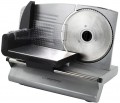Power
The total power consumption of the slicer. The value of this parameter is small — the performance of even the most powerful models usually does not exceed 200 W.
Almost all the power consumed is for operation of the engine, so the higher
it is, the more powerful the engine is installed in the slicer. Theoretically, the higher power allows you to better cope with solid and dense products, but in fact everything also depends on the characteristics of the knife — primarily its type (see below) and the quality of sharpening. Therefore, power data are more reference than practically significant, and this indicator has almost no effect on the quality of the slicer.
Blade type
The type of blade that comes standard with the slicer.
All knives used in this category of kitchen appliances are circular, rotating, and the blade in them goes in a circle. But the shape of this blade can be different — it is in this parameter that the types of knives differ from each other.
—
Straight. Knives with a traditional straight blade are basic and affordable, yet with proper sharpening and skill, they can handle various slicing tasks effectively. They excel with products of uniform consistency like cheese but may be less effective for slicing non-uniform density items such as bread compared to knives with wavy or notched blades.
—
Wavy. Knives with a wave-shaped blade are more difficult to manufacture and more expensive than straight ones. On the other hand, they do an excellent job not only with homogeneous products, but also with those that have different density — like ham with a crust.
—
Serrated. Serrated knives have sharpening in the form of pronounced sharp teeth, resembling those of a circular saw. They are beneficial for slicing products with varying density, similar to wavy blades. Serrated knives are particularly effective for cutting vegetables and fruits with tough peels and soft cores, like tomatoes or peaches. However, these knives tend to be more expensive due to their specialized design.
No
...te that some models may come with several removable blades of different types. This allows you to choose an option depending on the situation — for example, cut the cheese with a straight knife, and put the wavy one only when really necessary, so as not to wear it out much.Blade diameter
The diameter of the blade of the knife supplied with the slicer. Knives are shaped like discs — accordingly, the diameter of the blade is actually equal to the diameter of the disc.
The larger the blade, the larger ingredients the device can handle at a time and the “larger” the cut slices can be. At the same time, in fact it is rarely necessary to use a slicer for very thick products. Therefore, even in the most “large-caliber” modern models, the knife diameter usually does not exceed 300 mm.
Speed control
The ability
to adjust the speed at which the slicer blade rotates. This allows you to further adjust the operating mode to the specifics of a particular situation and type of products: for example, the slicer can easily cope with relatively soft and homogeneous ingredients at low speed, but for solid, dense or heterogeneous it is better to use the “fast” mode.
Note that this function, on the one hand, is rarely required in everyday life, on the other hand, it significantly affects the cost of the device. Therefore, the presence of an adjustable speed is typical mainly for advanced slicers.
Slicing tray
The presence
of a tray for chopped products in the design or delivery set of the slicer.
Such a pallet can be made both as a non-removable element and as a separate device that is not attached to the slicer body. However, this piece of equipment saves the user from having to look for a board, saucer, plate or other "seat" for chunks coming out from under the knife of the unit anyway. Of course, in a modern kitchen, finding such a “seat” is not a problem, but using a tray is often more convenient.
Foldable
The ability
to fold the slicer when it is not in use.
The meaning of folding in slicers is the same as in any other technique — it allows you to reduce the dimensions of the unit and make it more convenient for storage and moving from place to place. However the folding structure is considered less durable and reliable than the unibody; however, in this case, this difference is not fundamental.
Also note that this category also includes such a specific variety as built-in slicers — without the possibility of folding, such devices would be too bulky and would cause inconvenience when embedded.
Material
The main material used in the construction of the slicer.
—
Plastic. This material is characterized by low cost and is often used in inexpensive models. However, its use is not an unambiguous sign that the slicer belongs to the low-cost class. The fact is that although the reliability of plastic is considered relatively low (compared to metal), it is quite sufficient even for fairly powerful models. In addition, there are many varieties of this material on the market, including options with high strength rates. Therefore, the actual strength and reliability of plastic is usually directly dependent on the price category of the slicer.
—
Metal. On the practical side, metal is remarkable for its high strength: it is much more difficult to damage such a body than plastic. In addition, it gives the device a solid appearance. The disadvantage of this material is a higher cost — despite the fact that the real need for the mentioned strength indicators is quite rare.

